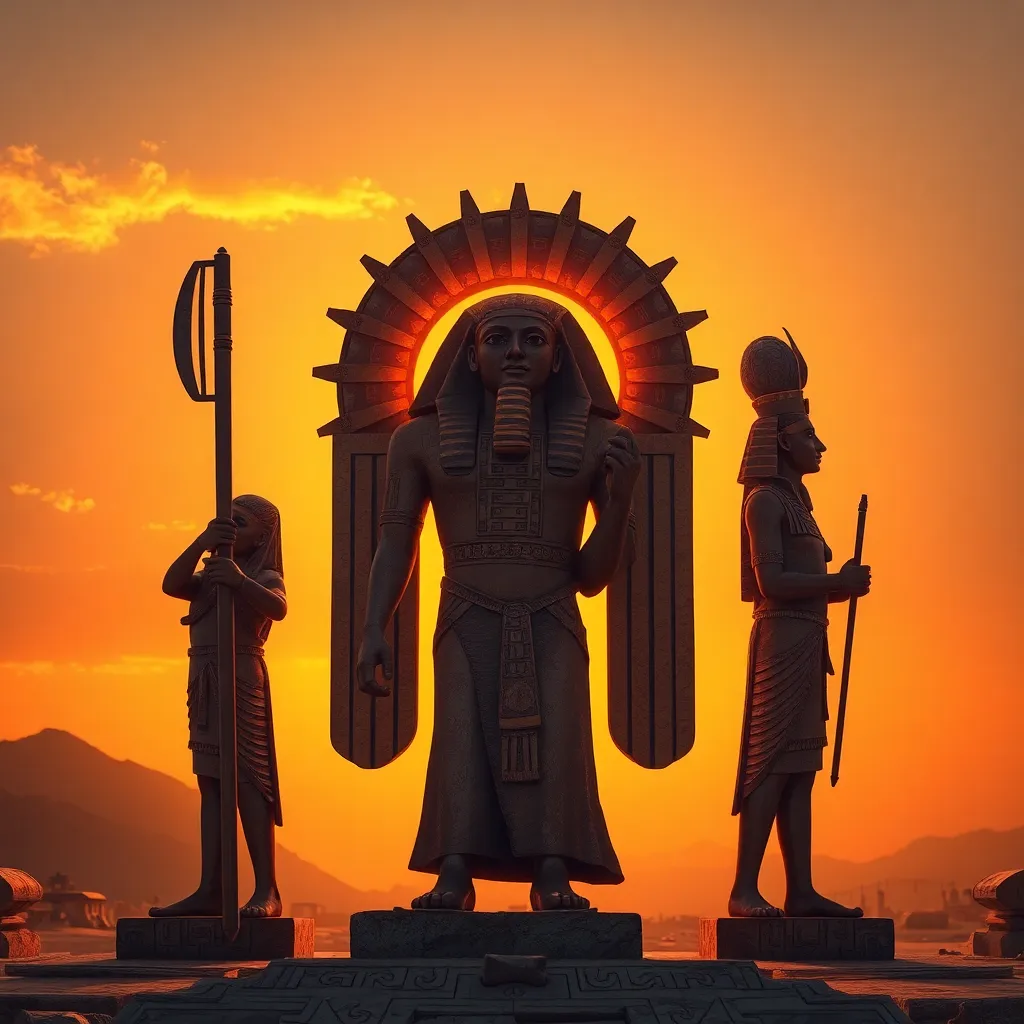The Sun God’s Role in Daily Life: Rituals of Aten Worship
I. Introduction
The ancient Egyptian civilization was deeply intertwined with its religious beliefs, and at the heart of this belief system was Aten, the Sun God. Aten was not just a deity but a central figure that influenced various aspects of daily life, politics, and art. His worship marked a significant shift in ancient Egyptian culture, particularly during the reign of Akhenaten, who elevated Aten to a position of prominence above all other gods.
This article aims to explore the rituals and daily practices associated with the worship of Aten, examining its historical context, theological foundations, and the impact of these rituals on both individual and community life in ancient Egypt.
II. Historical Context of Aten Worship
Aten worship has its roots in the early dynastic period of ancient Egypt, but it gained immense significance during the 18th Dynasty, particularly under Pharaoh Akhenaten.
- A. Origins of Aten worship in ancient Egypt: Initially, Aten was viewed as a manifestation of the sun, a natural phenomenon that Egyptians revered for its life-giving properties.
- B. The reign of Akhenaten and the establishment of Aten as a central deity: Akhenaten, known for his radical changes in religious practices, proclaimed Aten as the one true god, instituting a form of monotheism.
- C. Transition from polytheism to monotheism in Aten worship: This transition marked a significant departure from the traditional polytheistic practices that characterized ancient Egyptian religion.
III. Theological Foundations of Aten
Aten was not just a sun god; he represented various attributes that were integral to the Egyptian worldview.
- A. Attributes and symbolism of the Sun God Aten: Aten was often depicted as a sun disc emitting rays, symbolizing life, light, and nourishment.
- B. Relationship between Aten and other deities in Egyptian mythology: While Aten was elevated above other gods, he was still seen as a part of the divine order, with connections to gods like Ra and Horus.
- C. The concept of divine light and its implications for daily life: The light of Aten was believed to provide warmth and sustenance, influencing agricultural practices and social activities.
IV. Daily Rituals and Practices in Aten Worship
The daily life of ancient Egyptians was heavily influenced by their religious practices, especially in the worship of Aten.
- A. Morning rituals: Welcoming the Sun and its blessings: Every day began with rituals that honored Aten, including prayers and offerings to ensure the sun’s blessings for health and fertility.
- B. Offerings and sacrifices: What was presented to Aten: Common offerings included bread, beer, incense, and flowers, all aimed at appeasing and honoring the Sun God.
- C. Festivals and communal celebrations honoring Aten: Major festivals often involved large communal gatherings, music, dance, and feasting to celebrate Aten’s life-giving power.
V. The Role of Priests and Temples in Aten Worship
The priests played a vital role in maintaining the rituals and practices associated with Aten worship.
- A. Structure and hierarchy of the priesthood: The priesthood was organized hierarchically, with the High Priest of Aten holding the highest authority over temple activities.
- B. The significance of temples dedicated to Aten: Temples served as the central locations for worship, prayer, and communal gatherings, designed to reflect Aten’s divine light.
- C. Daily duties and responsibilities of priests in maintaining rituals: Priests performed daily rituals, maintained temple offerings, and educated the community about Aten’s significance.
VI. Aten Worship in Family and Community Life
The worship of Aten permeated both family structures and community life, reinforcing social bonds.
- A. Household rituals and the importance of daily prayers: Families often engaged in daily prayers to Aten, seeking protection and blessings for their household.
- B. The role of family in honoring Aten: Each family member had specific roles in honoring Aten, from the head of the family to the children, fostering a sense of unity.
- C. Community gatherings and their impact on social cohesion: Community rituals and festivals not only honored Aten but also strengthened communal ties and shared cultural identity.
VII. Artistic Representations of Aten Worship
The artistic expressions of Aten worship were significant in conveying the deity’s importance and the values of ancient Egyptian society.
- A. Iconography and symbolism in art dedicated to Aten: Artistic representations often depicted Aten as a sun disc, with rays ending in hands offering life and blessings.
- B. Temples and monuments: Architectural significance: Temples dedicated to Aten were designed to capture sunlight, emphasizing the connection to the divine.
- C. Literature and inscriptions reflecting Aten’s influence: Texts from this period often included hymns and prayers to Aten, emphasizing his role in daily life and governance.
VIII. The Decline of Aten Worship and Its Legacy
After the reign of Akhenaten, the worship of Aten began to decline, giving way to the traditional polytheistic practices of ancient Egypt.
- A. Factors leading to the decline of Aten worship after Akhenaten: The return to traditional beliefs was partly due to political changes and the disillusionment of the populace.
- B. The resurgence of polytheism and the fall of the Aten cult: Following Akhenaten’s death, subsequent rulers reinstated the worship of the old gods, leading to the decline of Aten.
- C. Lasting impact of Aten worship on subsequent religious practices in Egypt and beyond: Despite its decline, the concept of monotheism and the idea of a singular god influenced later religious thought.
IX. Conclusion
Aten’s significance in daily life and rituals illustrates the complexity of ancient Egyptian religion and its profound impact on culture and society. Understanding these practices helps us appreciate the rich tapestry of beliefs that characterized ancient Egypt.
In reflecting on the enduring legacy of the Sun God, we recognize how the worship of Aten paved the way for future religious developments, emphasizing the interplay between culture, religion, and daily life that resonates even in contemporary society.




